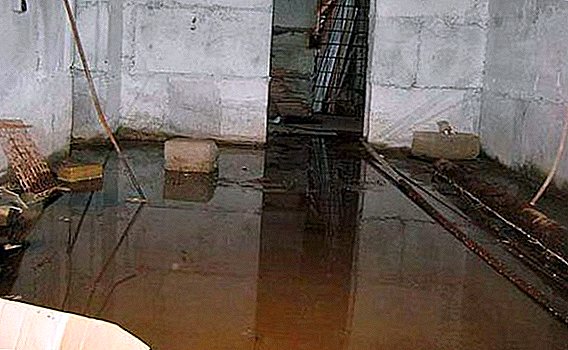 With the advent of water in the basement most often faced by the owners of private houses and cottages. This phenomenon not only makes it impossible to use basements for household needs, but also has a detrimental effect on the entire structure. Often, flooding is caused by groundwater - consider what measures should be taken to get rid of unnecessary fluid in the basement, and the reasons for its occurrence.
With the advent of water in the basement most often faced by the owners of private houses and cottages. This phenomenon not only makes it impossible to use basements for household needs, but also has a detrimental effect on the entire structure. Often, flooding is caused by groundwater - consider what measures should be taken to get rid of unnecessary fluid in the basement, and the reasons for its occurrence.
Groundwater
The nearest aquifer from the surface of the earth, usually located in loose permeable rocks, is called groundwater. It is usually formed under the influence of precipitation and water ingress from surface water bodies. 
The groundwater horizon is variable and depends on various factors.
The most frequent of them are as follows:
- amount of precipitation, melt water;
- changes in reservoirs feeding groundwater;
- man-made human activity (hydroelectric power stations, canals and reservoirs, mining, industrial effluents, etc.).
In groundwater, there is a variety such as a water-pipe, a liquid that accumulates in the upper unsaturated layer of soil above water-resistant soils (clay, loam). It is she who gathers in the lowlands, blurs the roads and is most dependent on precipitation.
Learn how to build a cellar in the country, how to make a cellar in the garage, how to install a plastic cellar, how to make ventilation in the cellar, how to get rid of rats in the cellar.
The ground water layer, unlike the artesian, has no pressure. In addition, this water is usually unsuitable for drinking and is polluted with various wastes, including man-made, often with aggressive impurities. 
Groundwater may have such aggressiveness:
- general acid;
- leaching;
- magnesia;
- sulphate;
- carbon dioxide.
All of them in one way or another dissolve calcium carbonate and lead to the destruction of concrete.
Did you know? On Earth, 96% of the water is in the oceans, about 1.5% is groundwater, and another 1.5% are the glaciers of Greenland and Antarctica. Moreover, the share of fresh water is only 2.5% - the overwhelming part of it is in groundwater and glaciers.
What is the danger to home
High water levels can adversely affect an existing structure:
- unwanted liquid, dampness and mold may appear in the basement, it will become unusable;
- aggressive admixtures of groundwater destroy concrete, and the foundation may lose its bearing capacity;
- accumulation during the period of rainy upper water can erode the paths on the site, wash down the walls, spoil the greenery.

A high level of groundwater is considered to be their location above 2 meters depth. But their occurrence below 2 meters is considered low and is welcomed by builders.
When building a house should always determine the level of groundwater in the area. Geological exploration can do this best of all. But if you do not want to use third-party services, then you can determine how far the groundwater is located by the level of liquid in the well at your site (or the next).
Moreover, it is best to measure this level in the fall, during seasonal rains, or in the spring, when there is a lot of snow melting. When building an expensive cottage is still to resort to specialized services.
Geological expertise will recommend the best location of the structure, the optimal choice of the foundation and drainage system.
Did you know? Groundwater level too high for housing construction can also be determined by national signs. It has long been observed that reed, horsetail, willow and alder grow in places of close bedding of water.
Groundwater in the basement and how to deal with them: video
Causes of water
Before you start draining the basement, you should determine the cause of the appearance of water and eliminate it as soon as possible. Only then you can drain the flooded places.
Undesirable liquid may appear in the basement for various reasons:
- closely located groundwater. This is the most common cause of basement flooding;
- accumulation of precipitation after rain with poorly established drainage system or its absence;
- ingress of melt water. This situation often develops with insufficient waterproofing of the structure and the absence of drainage to remove accumulated sediment. This is often observed in lowlands and other places of fluid accumulation;
- cracks in the foundation due to violations of construction technology;
- breaking pipes in the basement;
- condensation in case of poor ventilation.

How to remove water from the basement
If the basement is flooded, the following methods can be used to eliminate it:
- For a one-time pumping of unwanted fluid, you can use a low-cost vibration pump. But it can be used if the scale of flooding is small. In this case, it is important to check that there is no garbage in the water.
- Pumping out water using a drain pump. For this purpose, you can contact the appropriate company that provides services for pumping liquid, or purchase a pump and solve this problem on its own.
A pumping method using a pump is considered more efficient.
It may also be useful for you to learn how to build a Dutch stove, how to make a stove with a stove, how to choose a long-burning heating stove, how to install a water heater, how to choose a septic tank for the dacha.
To independently remove excess liquid from the basement with a pump, you need to adhere to the following instructions:
- in the center of the basement make the deepening and install a plastic tank, which plays the role of the drive. Holes are made in the body of such a tank;
- the tank is wrapped in geotextiles to protect from flooding. On the bottom pour fine gravel to install the pump;
- then a drainage pump is placed in the tank prepared in this way. The gap between it and the pit is filled with a mixture of concrete. The float located in the pump determines the required water level, and the system automatically turns on the pump for pumping liquid. After the pumping process, the system shuts down;
- To remove waste fluid from the basement, a hose or special pipes are connected to such a system.

Pump for pumping is of two types - submersible and external. When choosing a submersible pump, it is placed in a liquid medium, where it is located throughout the work. The outward pumps are mounted in water by a casing in its lower part, while the upper part is on the surface.
Thus, pumping out of wastewater occurs in the submersible part. To prevent the basement from flooding, it is necessary to take appropriate measures to set up a good drainage system.
What to do: how to prevent the penetration of water
In order to get rid of moisture in the basement, there are various methods, depending mainly on the cause of its occurrence.
Pit arrangement
The easiest way to eliminate the appearance of sewage in the basement on its own is to set up a pit. This method is inexpensive and does not require much time-consuming, therefore it is often used in private houses and cottages. 
To properly equip the pit, such steps should be taken:
- In the center of the basement, dig a hole in the shape of a cube about 1 m³ in volume. But it is worth considering - the larger the room, the more the pit is dug out;
- In the very middle of the dug pit, a groove is made in which a stainless steel bucket is placed. The ground around such a bucket is well packed;
- we lay out a dug hole with a brick, and then cover it with a cement layer about 2-3 cm;
- on top of the place a metal grid. The gap between the bars should allow the pump to pump out the liquid;
- dig small trenches in the pit and cover with tiles to form drains.
The joints between the tiles and will perform the function of drainage.
For the arrangement of the dacha you will be interested to learn how to make a summer shower, how to build a swimming pool, how to make concrete walkways, how to make a garden path from wood cuts, a decorative waterfall, a fountain, a brazier made of stone, a flower bed, a dry stream, an arbor with your own hands .
Drainage for drainage
This is a more complex, but effective method for removing unwanted fluids from the basement. It takes more material costs, and also takes more time and effort. It should be noted that there are several types of basement drainage.
DIY drainage: video
The choice of a specific drainage system depends on the following points: the terrain, the depth of groundwater, soil, and so on.
There are three main types of drainage system, each of them has its own specifics:
- Wall mounted. Such drainage is installed for buildings with a basement or basement. Its installation occurs immediately after the construction work on the arrangement of the foundation.
- Plast. This drainage system is installed at the time of excavation of the pit for the object under construction. It received application in construction from plates, therefore it is applied less often.
- Trench (ring). Such a drainage system can be installed on its own. It is made in the form of a trench dug round the walls of the house.
Important! The most effective is the trench system. The annular drainage system must be located 0.4-0.5 m deeper than the foundation level.
To make drainage for drainage, you should follow these recommendations:
- we dig a trench along the walls of the house around the width of not less than 1 m 20 cm with the help of shovels or special equipment;
- on 4 sides of the main ditch, it is necessary to install additional taps approximately 5 m in length. Also for this purpose, you can apply special equipment to speed up the process. At the end of such taps, a recess is dug, which should correspond in diameter to a ring of concrete;
- Geotextiles are placed along the bottom of the trench, and a corrugated pipe is laid on top of it for drainage. After 7 m, manholes are installed, where the drainage pipe is interrupted;
- after the pipe is laid, the trench is poured with rubble, and 10 cm to the basement - with sand, then a layer of large crushed stone goes, about 15 cm to the ground, and finally it is poured concrete over the top.

Waterproofing
To protect the house from the water in the basement, waterproofing is used. Basement waterproofing is divided into two types - internal and external.
External waterproofing is better to install during the construction of the house, because such a system for existing buildings requires much more labor and money.
In this case, you have to dig up the foundation and apply several layers of waterproofing, and then you will need to lay the soil around the outer walls in several layers - from sand, rubble and pour concrete on top.
Usually during such works a circular drainage system is installed at the same time, which also significantly increases their cost. 
External waterproofing is performed in two ways:
- Pasty. It provides for the use of roll materials.
- Obmazochny. In this method, polymeric materials are used, as well as mastic from bitumen.
External waterproofing is the application of a plaster on the prepared surface, and then the rolled building material is laid on top of several layers. It should be taken into account: when underground waters are close enough to the foundation, then additional protection is needed for waterproofing in the form of masonry made of bricks.
Sometimes, instead of such masonry, profile membranes with a geotextile pad are used. This method reliably protects the walls from water. Special geotextiles provide an empty gap between the spikes of the membrane, which serves as a channel for the withdrawal of effluent.
Important! External waterproofing for reliability should be done at 30 cm above ground level. To improve drainage before pouring concrete mix, it is desirable to put a layer of clay.

External waterproofing can be installed with their own hands, subject to the following order:
- the mastic is first applied to the outer wall;
- on mastic the rolled material keeps within. Strongly on a roll when laying it is not necessary to put pressure, mastic, and so secure the material. In order for the canvas to lie flat, you need to roll it with a roller;
- then the next surface is treated with mastic and the next roll of material is applied. The rolls on each other should be about 10 cm, therefore, when applying the rolled material to the wall, it is necessary to coat the adhesive with a special adhesive mixture 15 cm from the edge;
- each applied canvas is rolled with a roller, including along the seams. The order of placement of the rolls (start from the bottom or top) does not matter;
- excess material at the joints can be removed with a knife.
Internal waterproofing is mainly performed from special formulations with penetrating effects that are best applied to fresh concrete. They are well protected from moisture penetration: when they hit the porous surface of concrete, interacting with water, they contribute to the formation of crystals that fill all microcracks. 
Internal waterproofing can be made using polymer-cement mineral compounds that are applied to wood, concrete and ceramic surfaces. Such compositions are simply diluted with water, and they are ready for use.
But it is worth considering that this waterproofing is not too resistant to temperature extremes, so there is still a need to use elastic sealants.
In private homes, you can make the internal waterproofing of the basement with your own hands. Before that, the basement should be drained, and all walls and the floor should be well cleaned of dirt.
Then produce the following work:
- all surfaces are treated with a waterproofing compound that protects against moisture;
- mastic coat the corners, seams and cracks, as well as all surfaces with a layer of 2-3 cm;
- on the walls, as well as the floor install a grid of metal;
- the floor is poured with concrete, and the walls are also coated with concrete;
- then plaster walls (about 3 cm thick).
When unwanted moisture has appeared in your basement, you should first quickly determine the source of its appearance and then take measures to eliminate excess fluid and prevent its appearance. If we arrange the drainage communications and waterproofing of the basement in a timely manner and correctly, then it will be dry and in the rainy periods.
Feedback from network users
A friend for many years struggled with flooding the basement. No waterproofing helped - water found a hole. I went completely to radical measures - around the house I dug a ditch with more than 2 meters deep, laid drainage pipes, brought them to 4 wells in the corners, covered ditches with crushed stone. And at the bottom of the wells I put 4 pumps, which themselves turn on when water appears.















